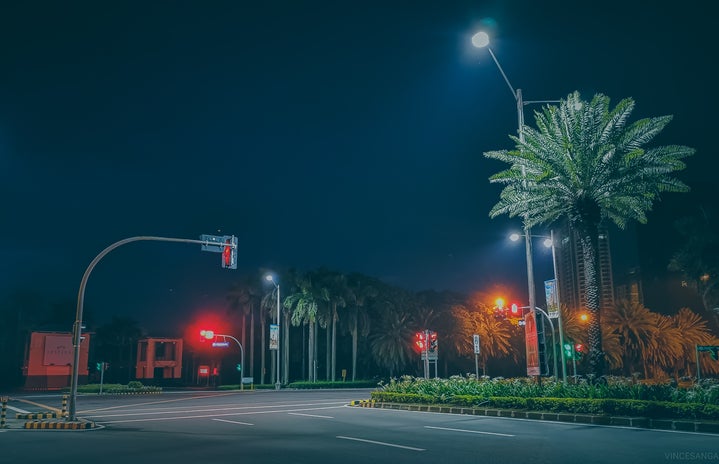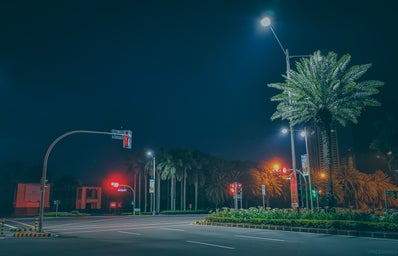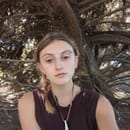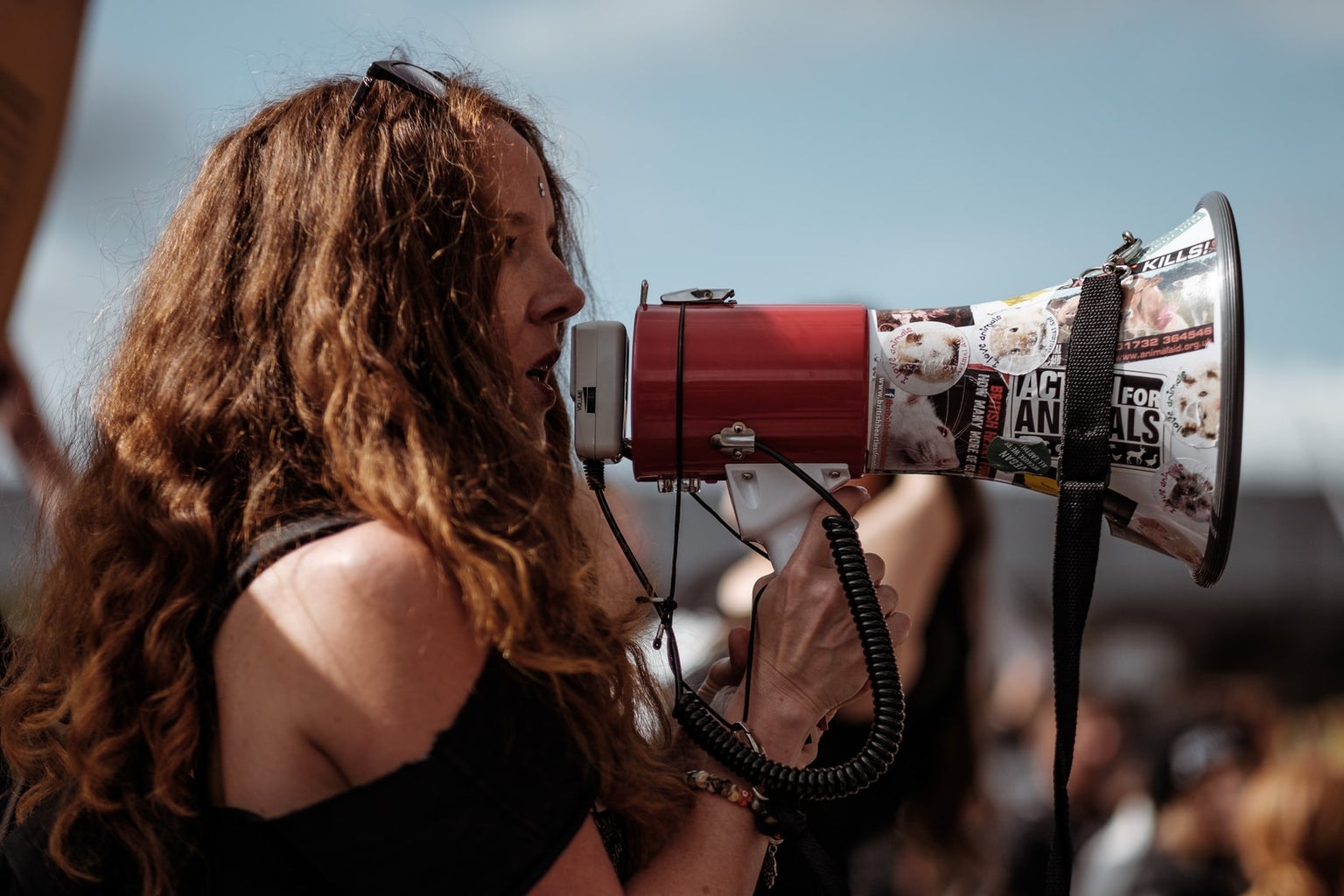A bike light glances at you for a moment, cutting through the spots of black between the street lamps. There are parts of campus that are so dark they seem to crowd in on you. Unfamiliar metal fencing leans over you, an unbroken borderline. You quicken your pace, circling the seemingly endless blockade around your dorm. Finally, the one entry point, a security checkpoint. Patting your pockets–key fob, student ID–you scramble to prove your innocence and enter.
At last, a begrudging jerk of the head and you’re free to stumble into your own room. The fence bars your window, obscuring your view of the wasted streets outside. There’s something about the quiet platoons of cops patrolling empty neighborhoods. Something about the bulk of Kevlar on their backs. You can’t sleep without drawing the blinds. Even still, the streetlights’ gaze burns through.
You’re a student going home on the first day of Halloweekend–the only weekend of the year that starts on a Tuesday. For a full two weeks, your dorm will be barricaded from the street. In fact, according to UCSB Associated Students Office of the EVPLA, “fencing will be placed near all of the residence halls except the Chi 5,” and dorms will be “resident access only” with “vehicle checkpoints” at some. UCSB Residential Policy already prohibits guests during Halloween, yet the university continues to put up visual boundaries to create an atmosphere of restriction and watchfulness.
In cooperation with UCSB’s parking and Residence Hall restrictions, the Isla Vista Foot Patrol is consistent in its aggressive preventative measures against the “Sex, drugs, riots, and lingerie” of past IV Halloweens (as described by SBCC’s The Channels in 2004). The Associated Students’ dedicated Halloween restrictions webpage cites an intense noise ordinance as one of the main pillars of this crackdown, with the risk of fines “exceeding $500.” It lasts for the duration of a ‘Halloweekend’ that stretches from “Tuesday, 10/26 through Thursday, 11/4, 6 p.m. to 7 a.m.”
The result is perfectly on theme for the holiday: a genuine ghost town. Del Playa, usually unnavigable by car and teeming with herds of party-goers, suddenly becomes a perfectly drivable street for two weeks. An eerie silence settles between Pardall Tunnel and Coal Oil Point. The scene, in short, is dead. Every year, an obligatory opinion piece in publications like News Channel 3-12 quotes students and police thanking each other for “keeping it safe and local.” Despite invasive security measures from the school and the Isla Vista Foot Patrol, there is a complacent attitude among students and community members alike out of respect for ‘the peace.’
It’s an artificial peace that goes against what has long been the lifeblood of UCSB: madness, chaos, and resistance. An informed eye may see what the party line at the university will not tell you: these measures for ‘peace’ were established to suppress “revolutionary behavior in the area,” according to the Daily Nexus. Our first wild Halloweens, complete with riots, were part of a pattern of civil unrest that included the “infamous burning of the Isla Vista Bank of America building in February 1970.”
The history of Halloween in Isla Vista is not just a history of debauchery, alcohol poisoning, and out-of-towners. It is also one of rebellion against authority, against cops: the kind of rebellion that blazed through the 1970s. When university voices exalt the effectiveness of their 14-day panopticon, pointing to falling crime rates– falling attendance rates–for IV Halloween, they are celebrating the decades-long suppression of a directed, politically-motivated unrest.
However, the ghost of protest is not the only one haunting our streets: IV’s history of meaningless, dangerous chaos on Halloween cannot be denied. It was not only characterized by high attendance and wild parties but also genuine danger and violence that harmed civilians. The Daily Nexus reports an Office of Student Life record stating that “A female UCSB student who thought she had been hit by flying rocks went three days with a bullet in her chest before discovering that she had been shot,” in Halloween 1986. A 2007 Nexus interview with the IVFP describes seizing “a [real] chainsaw from a guy playing chainsaw massacre.”
In a town whose response to rioting was to form its own police force, keeping civilians safe amid mayhem seems synonymous with increased police presence. However, a lot is lost when it’s taken for granted that the solution to violent parties is completely shutting down the town. Even increasing the severity of law enforcement measures, as was attempted before the total Halloween ban, is not necessarily a response that can be condoned.
The intense policing of IV, especially on Halloween, takes a step beyond reasonable measures for establishing societal order. Peace often comes at the expense of certain freedoms, but when you can’t sit on a curb (drunk or not) without being harassed by the police, you are paying too much for your peace. When you find yourself face to face with a dorm fenced in for purely fear-cultivating purposes, it is certain that you are paying too much for your peace.
Without the frightening sacrifice of freedom for the order that is an IVFP-enforced lockdown, what would a “safe Isla Vista” look like? Despite their cop-adjacent uniforms, the CSOs set a good example. Against all appearances, they are not a punitive force. Their role is truly to encourage harm reduction and safety: all they do is sit under their tent offering water, help, and a walk home to drunk kids. The same principle guides Jesus Burgers, a community organization offering harm reduction in the form of free food at the peak of party hours on the weekends.
Simple as they may be, the actions of the CSOs and the acolytes of the Burger are excellent examples of the steps to police abolition in action. When the IVFP arrests and tickets people from their dizzy post on the curb, they are reacting to the problem rather than working to solve it. Dangerously drunk college students can’t be fined out of existence, nor can their unruly behavior.
Of course, the motivation from both entities is to encourage ‘better behavior,’ but their effect does not involve shame, control, or the court system. Instead, they do their best to feed and hydrate away the drunk and disorderly. UCSB itself has gestured at prevention measures like education about responsible alcohol and drug use, although the current model (an online course and a long lecture) is far from effective. The same can be said of UCSB’s mental health programming–treating would-be perpetrators of violent crime could be very effective if only CAPS had more to offer than peer groups, peer counselors, and at most two sessions with a trained professional.
Funding should be directed at effective, harm-reducing community organizations that actually mitigate crime, rather than at more barricades and police officer salaries. Police don’t stop violent crimes from happening, they only punish them (sometimes).



